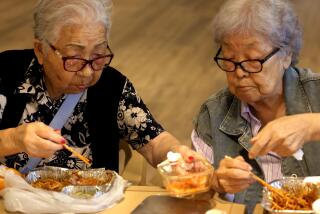Japanese gardener one of the last of a disappearing breed
His hands are like bronze mitts — cracked and weathered by labor, age and too much sun. But his touch is soft.
He cups the branch of a willowy shrub and nods toward the hills for which it is named. “This is a Hollywood juniper,” Tadashi Hamada says. He knows the breed well. An evergreen with twisted tufts, it is native to his birth country, Japan. This one is planted in front of his Mid-City home, where the paint peels and the stoop sags.
Fishing a pair of clippers from his pocket, Hamada begins to prune. Needles flutter to the ground. He squints. At 75, his eyes don’t always behave.
“Better,” he announces. “Too many bushes die inside because sun doesn’t hit it.”
With that, Hamada climbs into his white Chevrolet truck to begin his Wednesday route. He puts the clippers in the glove compartment. They won’t be touched again for the rest of the day.
Decades ago, when Hamada first became a gardener, much of the work was done by hand. Pruning bushes and planting flowers were common practice. But the job has been whittled down to mowing lawns and whacking weeds — hitting as many yards as possible.
The identity of those in the business has also changed. The Japanese gardener, once a common figure in Los Angeles and surrounding areas, is fading from the landscape.
A sign that an era is drawing to a close came earlier this year when a gardeners’ co-op in Little Tokyo was shuttered. The tiny warehouse sold gardening goods at fair prices and had once served thousands of Japanese American gardeners.
But members have retired or died. They have persuaded their children to dream bigger.
The issei never expected the second and third generation to take up such a grueling trade. Gardening was always meant to be a means of support, not a legacy to pass down.
::
The first wave of Japanese in California intended to own land, not till it for others. Thousands of immigrants moved to rural areas to take jobs as farmhands. They eventually gained their own plots until a law passed in 1913 that forbade land possession or leases longer than three years for “aliens ineligible for citizenship.” At the time, Asians were barred from naturalization. Some put leases in their American-born children’s names.
Gardening was a natural move at a time of limited opportunity. It was year-round work without a boss that required little startup cash and minimal English skills.
Local organizations of gardeners cropped up and members swapped techniques, advice and politics.
But any foothold the community gained was swept away when the United States entered World War II. With their U.S. government-ordered internment, Japanese Americans lost homes, belongings, momentum, roots.
When the order for internment ended, lingering anti-Japanese sentiment still meant few options — even for the second generation and well educated.
At one time historians estimated that one in every four Japanese American men was a gardener. It was menial work that required weekends, but it allowed them to buy homes, send their kids to college. Some women joined their husbands or took over routes when widowed. Gardeners became the cornerstone of the Japanese American community, establishing schools and churches.
Japanese gardeners with the pith helmet also became a status symbol, their services requested by celebrities. Their cachet came in part from a tendency to assume that immigrants are made for the jobs they take on: in this case, the Japanese gardener, a humble servant whose mystical Eastern philosophy grants him a flair for plants and agriculture.
The assumption glossed over their struggles. “A lot of immigrants were actually from agricultural backgrounds, but it wasn’t like there was horticulture magic implanted inside them — there’s many stories of Japanese who were awful at gardening,” said author Naomi Hirahara, who edited a book on Japanese gardeners.
Some used the stereotype to their advantage: Hirahara’s father was American born but handed out business cards that said he specialized in “Oriental gardening.”
In 1955, thousands of Japanese Americans formed the Southern California Gardeners’ Federation. The organization offered health insurance, hosted conventions, published a newsletter and coordinated picnics.
A perk of membership was access to the federation co-op, a Little Tokyo depot where the shelves were laden with essentials like sprinkler parts, fertilizer, gloves and pesticide or specialty hand shears made in Japan. But the co-op closed in March. The federation’s membership had shrunk to around a thousand, most of whom are retirees or widows who remain because of the health insurance. Only about 100 members work full-time.
“Everybody said OK, the time has come,” said former co-op president Yasunori Arakaki. He estimates the federation itself has another 20 years before it too is gone.
Gardeners often brought their children on the job, if only to encourage them to aspire to something else. A few third-generation gardeners exist, but they too envision a different future for their children. The youngest members of the federation are in their 40s.
Older gardeners like Makoto Shirasawa say they’ve stuck around because working seems more bearable than an idle life.
“My philosophy is just keep moving,” said Shirasawa, 72. “I’ll probably never retire. It’s nice to be outside, I don’t want to be sitting in a chair watching TV.”
Shirasawa has been in this line of work for more than four decades. It is not what he envisioned when he left Kagoshima, Japan. He was young, America was vast and he imagined it a charmed country.
For three years he picked strawberries on a Torrance farm and took English language classes. He studied horticulture at Cal Poly Pomona and worked part-time at a nursery. Gardening seemed a viable trade, and he bought an old truck and equipment.
Although some of his clients treat him like family, he has plenty of memories that sting. His customers’ neighbors have yelled at him or demanded that he rake their yards, too. Once a woman turned a hose on him when he tried to quiet her yapping dog. A few clients have requested he park his truck far from the house.
“My pride still gets hurt,” Shirasawa said. “It’s kind of dehumanizing. The Japanese gardener is a dying breed, but that’s the way it’s going to be because I don’t recommend this business. I know how tough this is, and we don’t get any respect. I don’t want to subject my people to that degradation.”
::
A juniper here, a bonsai tree there — Hamada, the Mid-City gardener, points them out as he maneuvers his truck through his rounds in the Crenshaw district.
He pulls up to a house decked with ivory calla lilies and red amaryllis. After exiting the truck, he pulls on a pair of gloves. It isn’t that agriculture comes naturally to the Japanese, he explains, it’s that it was taught naturally.
“As a kid we watched our father, grandpa take care of the yard,” he says. “Even in school they teach you how to trim the tree, about vegetable gardens.”
He was 21 when he arrived in America and got a job picking fruit at a Fresno farm. Fellow issei talked him into gardening 50 years ago.
Now, shrinking budgets mean homeowners and landlords are often looking for “mow, blow and go” crews. No longer considered a luxury, yardwork has become devalued, with gardeners forced to hustle and focus on quantity. A large Latino immigrant workforce has brought down rates.
Hamada jerks the mower’s starter cord until it sputters and roars, then pushes and pulls it across the grass, creating diagonal lines. No sign of his earlier delicateness here. The sun is blazing, and other houses await.
When he straps on the blower, he is instantly a cloud of white noise and scurrying blades of grass.
And then he is done. It is a 30-minute job he does once a week for 50 bucks a month. With about 30 customers, the paydays are small. The equipment, however, only gets pricier. A $1,200 mower was once stolen at gunpoint.
“I used to warn my friends’ kids about this,” Hamada says. “Hey, you don’t study hard, you’re going to become a gardener.”
One day, he says, he’ll retire and tend only to his own garden. But as he packs up to head to the next home, Hamada points out that the neighbor has a king sago palm — a plant native to Japan.
“It’s about 120 years old. It doesn’t look good.”
A woman walks out of the neighboring house.
“You gotta cut it, shape it up,” he calls to her, gesturing at the plant. “If you bought this at a store it’d cost about $6,000. Save it. It looks too crowded.” The woman smiles but appears confused.
Hamada clambers back into his truck. He shakes his head.
“This is Japanese way. After we’re dead, probably nobody will take care of it this way. That’s the only thing that makes me sad.”
More to Read
Sign up for Essential California
The most important California stories and recommendations in your inbox every morning.
You may occasionally receive promotional content from the Los Angeles Times.











